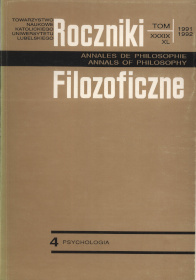Endler’s Multidimensional Scales of Anxiety (EMAS)
Abstract
The paper depicts Endler’s multidimensional scales of anxiety (EMAS). On designing the method the author based himself on the interaction model of personality in which anxiety is taken to mean the resultant of the interaction of personality and situational variables. Endler distinguishes the state and trait of anxiety, and assumes that they are multidimensional constructs. EMAS consists of three independent scales.
EMAS-State (EMAS-S) is used to measure the state of anxiety and consists of 20 items which grasp two components of anxiety, i.e. autonomic-emotional and cognitive (cognitive-worry). EMAS-Trait (EMAS-C) is designed to measure the trait of anxiety. It consists of 60 items which encompass the individual’s predispositions to live anxiety in four different situations: social evaluation, physical danger, unclear-new situation and in everyday life situation. EMAS-Perception (EMAS-P) grasps anxiety reaction in the situation of testing.
Preliminary researches by means of the Polish version of the scale EMAS-C point at its diagnostic character and clinical suitability. One postulates further standardized studies of this original tool for the examination of the psychological aspects of anxiety.
References
Auerbach S. M.: Effects of Orienting Instructions, Feedback Information and Trait Anxiety on State Anxiety. „Psychological Reports” 33:1973 s. 779-786.
Auerbach S. M.: Trait-State Anxiety and Adjustment to Surgery. „Journal on Consulting and Clinical Psychology” 40:1973a s. 264-271.
Cattell R. B.: Anxiety and Motivation. Theory and Crucial Experiments. W: C. D. Spielberger (ed.). Anxiety and Behavior. New York 1966.
Cattell R. B., Scheier I. H.: The Nature of Anxiety: A Reviev of 13 Multivariate Analyses Comparing 814 Variables. „Psychological Reports” 5:1958 s. 351-388.
Cattell R. B., Scheier I. H.: The Meaning and Measurement of Neuroticism and Anxiety. New York 1961.
Derogatis L. R.: SCL-90R (Revised Version) Manual. Baltimore 1983.
E n d l e r N. S.: Interactionism. A Personality Model but not Yet a Theory. W: M. M. Page (ed.). Nebraska Symposium on Motivation. Personality-Current Theory and Research 1983. Lincoln 1983.
Endler N. S., Edwards J. M.: Evaluation of the State-Trait Anxiety Concept within an Interactional Model. „The Southern Psychologist” 2:1985 s. 63-71.
Endler N. S., Edwards J. M., Kowalchuk B. P.: The Interaction Model of Anxiety Assessed in a Psychotherapy Situation. „The Southern Psychologist” 1:1983 s. 168172.
Endler N. S., Edwards J. M., Vitelli R.: Endler Multidimensional Anxiety Scales. Manual. Los Angeles 1991.
Endler N. S., Edwards J. M., Vitelli R., Parker J. D. A.: Assessment of State and Trait Anxiety. Endler Multidimesional Anxiety Scales. „Anxiety Research. An International Journal” 2:1989 s. 1-14.
Endler N. S., Hunt J., R o s e n s t e i n A. J.: An S-R Inventory of Anxiousness. „Psychological Monographs” 76:1960 s. 1-33.
Endler N. S., Lobel T., Parker J. D. A., Schmitz P.: Multidimensionality of State and Trait Anxiety. A Cross-Cultural Study Comparing American, Canadian, Israeli and German Young Adults. „Anxiety Research. An International Journal” 3:1991 s. 252-272.
Endler N. S., Magnuson D.: Multidimensional Aspects of State and Trait Anxiety. A Cross-Cultural Study of Canadian and Swedish College Students. W: C. D. Spielberger, P. Diaz-Guerrero (eds.). Cross-Cultural Anxiety. Washington 1976.
Endler N. S., Magnuson D.: Toward an Interaction Psychology of Personality. „Psychological Bulletin” 83:1976a s. 956-974.
Endler N. S., Magnuson D., Ekehammar B., Okada M.: The Multidimensionality of State and Trait Anxiety. „Scandinavian Journal of Psychology” 17:1976 s. 8196.
Endler N. S., Okada M.: A Multidimensional Measure of Trait Anxiety. The S-R Inventory of General Trait Anxiousness. „Journal of Consulting and Clinical Psychology” 43:1975 s. 319-329.
Endler N. S., Parker J. D. A., Bagby R. M., Cox B. J.: Multidimensionality of State and Trait Anxiety. Factor Structure of the Endler Multidimensional Anxiety Scales. „Journal of Personality and Social Psychology” 6:1991 s. 919-926.
Endler N. S., Shedletsky R.: Trait Versus State Anxiety, Authoritarianism and Ego Threat Versus Physical Threat. „Canadian Journal of Behavioral Science” 5:1973 s. 347-361.
Flood M., Endler N. S.: The Interaction Model of Anxiety. An Empirical Test in an Athletic Competition Situation. „Journal of Research in Personality” 14:1980 s. 329-339.
Hodges W. F.: Effects of Ego Threat of Pain on State Anxiety. „Journal of Personality and Social Psychology” 8:1968 s. 364-372.
Jackson D. N.: Basic Personality Inventory. Port Huron 1989.
Liebert R. M., Morris L. W.: Cognitive and Emotional Components of Test Anxiety. A Distinction and Some Initial Data. „Psychological Reports” 20:1967 s. 975-978.
Mischel W.: Personality and Assessment. New York 1968.
Sarason I. G.: Test Anxiety, Attention and the General Problem of Anxiety. W: C. D. Spielberg, I. G. Sarason (eds.). Stress and Anxiety. Vol. 1. New York 1975.
Schwartz G. E., Davison R. J., Goleman D. J.: Patterning of Cognitive and Somatic Processes in the Self-Regulation of Anxiety. Effects on Mediation Versus Exercise. „Psychosomatic Medicine” 40:1978 s. 321-328.
Spielberger C. D.: Theory and Research on Anxiety. W: C. D. Spielberger (ed.). Anxiety and Behavior. New York 1966.
Spielberger C. D.: Anxiety as an Emotional State. W: C. D. Spielberger (ed.). Anxiety. Current Trends in Theory and Research. Vol. 1. New York 1972.
Spielberger C. D., Edwards C. D., Lushene R. E. i in.: STAIC Preliminary Manual for the State-Trait Anxiety Inventory for Children. Palo Alto 1973.
Spielberger C. D., Gorsuch R. L., Lushene R. E.: Manual for the State-Trait Anxiety Inventory. Palo Alto 1970.
Taylor J. A.: A Personality Scale of Manifest Anxiety. „Journal of Abnormal Psychology” 48:1953 s. 285-290.
Uchnast Z.: Endlera wielowymiarowe skale niepokoju (wersja eksperymentalna). Lublin 1993 (mps Zakład Psychologii Ogólnej KUL).
Wine J.: Test Anxiety and Direction of Attention. „Psychological Bulletin” 76:1971 s. 92-105
Copyright (c) 1992 Roczniki Filozoficzne

This work is licensed under a Creative Commons Attribution-NonCommercial-NoDerivatives 4.0 International License.





